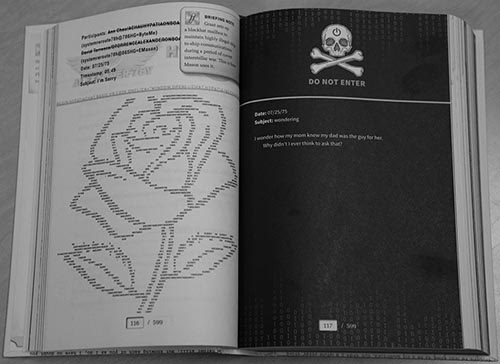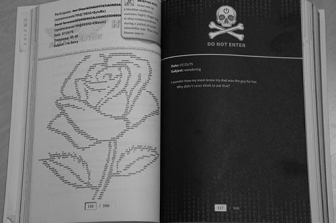
On Oct. 20, Australian authors Jay Kristoff and Amie Kaufman will debut their YA collaboration Illuminae, the first book in the science fiction Illuminae Files trilogy.
The novel follows the young couple Kady and Ezra, who are forced to flee when their planet is bombed by the first attack in an intergalactic war. The two are separated on different refugee ships, only able to communicate through a hacked messaging system.
This, however, is the least of their problems: the refugee ships are being pursued by enemy warships, a deadly plague threatens to kill everyone aboard, and an AI begins to betray its purpose of protecting the starships.
Although these may seem like cliche sci-fi novel plots, by using them together, the authors are able to create a storyline which is action-packed and always suspenseful.
However, the execution of this impressive idea is poor- by attempting to integrate the multiple different conflicts into a single plot, the novel is fragmented and distracting, not allowing the reader to focus on a single plotline. This not only takes away from the plot, but by making the novel so plot-packed, the authors leave no time to develop setting or character.
Illuminae sets itself apart with a breakthrough writing format- the novel is unconventionally structured as a collection of hacked documents, chat logs, and even files from the data core of the AI.
The format takes the story to another level, engaging the reader in documents that can never tell the whole story — the novel create suspense with snippets of life conveyed through the documents.
This works especially well with a sci-fi novel — it illustrates how technology is on track to become our only form of communication. The format immerses us in a completely online world, emphasizing the futuristic world Kady and Ezra live in.
However, the format does have its shortcomings. Because it uses only documents to tell its story, the novel lacks sensory language and imagery, making it hard for the reader to engage well with the characters — the format only portrays the character through the online aspect of their lives, making them one-dimensional and boring.
Furthermore, towards the end of the novel, data from the AI takes up most of the pages — mostly black ink, the few white words on each page add almost nothing to the plot. The typography makes the writing visually appealing, but otherwise, the 100 pages from the AI data core are a waste of ink and paper.
The novel also lacks thematic weight — in part because of the format, Illuminae doesn’t give the reader much other than an interesting story — while the authors attempt to tell a message regarding the dangers of technology, the format, ironically, buries it too deep into the story.
Despite these flaws, the novel’s plot and format work extremely well together — both take science fiction to a new level of complexity where no author has ever ventured before. The plot, filled with AI takeovers and huge spaceships, wouldn’t be the same without the email and chat log based format.
Illuminae’s graphic design is one of the book’s best qualities. Working well with the hacked document format, the novel has diagrams, beautiful typography, and even ASCII drawings, adding a new dimension to the writing, and immersing the reader in the story.
Overall, despite its hindrances, Illuminae makes strides in exploring new, modern writing styles that will almost undoubtedly be used, and perhaps more importantly, perfected by future authors. Illuminae’s plot brings everything expected of a good science fiction novel and more, leaving readers eagerly waiting for the sequel.



